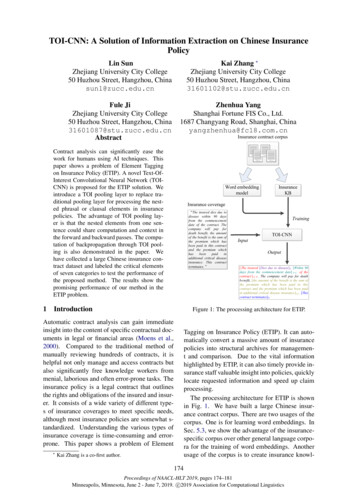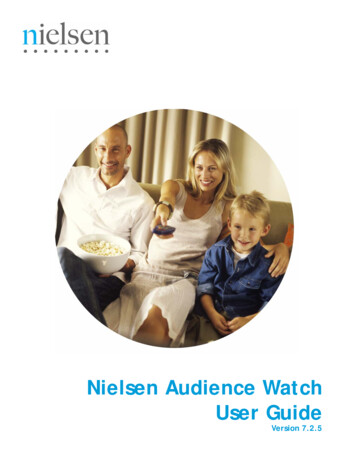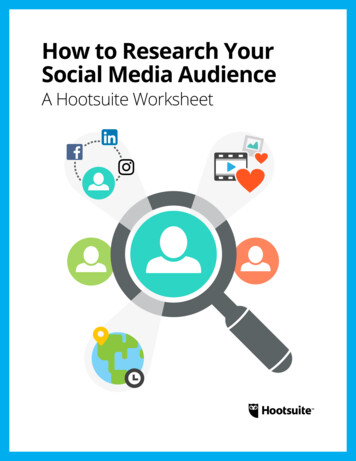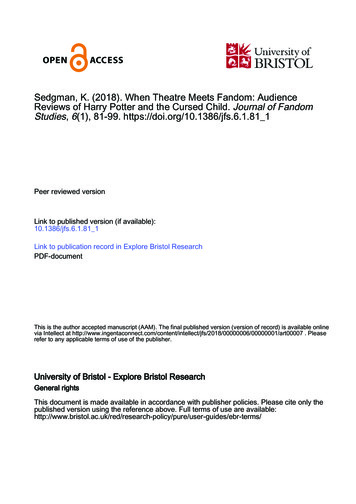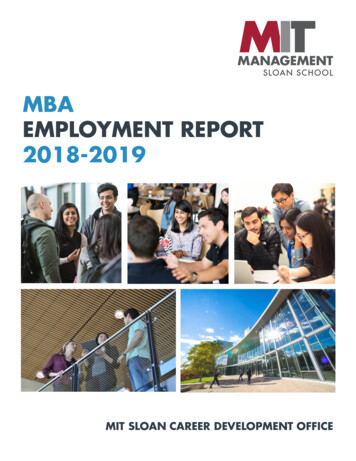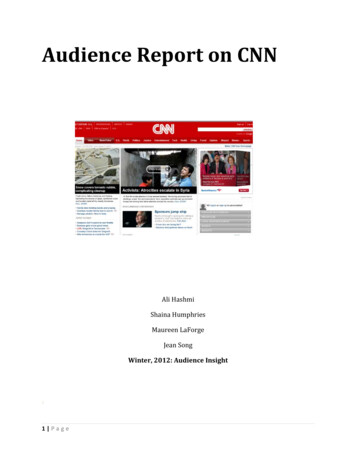
Transcription
Audience Report on CNNAli HashmiShaina HumphriesMaureen LaForgeJean SongWinter, 2012: Audience InsightF1 Page
IntroductionFounded in 1980 by Ted Turner, Cable News Network was the first 24-hour televisionnews channel in the world. Some called it the “Chicken Noodle Network” because they lostrevenue at a rate of 2 million dollars a month in their first year. CNN was even deniedaccess to the White House pool in the early 1980s. However, they grew to be one of thelargest news organizations, reaching 100 million households in U.S. and 265 millionhouseholds abroad 1. “He who laughs last, laughs best. They’re not laughing anymore,”Turner said in an interview with Michael Rosen in 1999. “I’m doing the laughing now.” 2CNN’S PERSONABased on our own data and research, as well as that of the Pew Research Center and theProject for Excellence in Journalism, we have identified the persona of CNN’s audience.This person is a college-educated woman 3 between the ages of 25 and 54, who tends tolean to the political left—but prefers her news to be neutral, and who cares mostly aboutnational news as opposed to international and local news. She is on-the-go and does nothave a lot of spare time to just sit around and watch the news on TV or read a newspaper.She receives most of her news online or through her smartphone, but often watches cabletelevision news for quick, short periods of time.1CNN Worldwide Fact Sheet.” Web. 03 Mar. 2012. http://cnnpressroom.blogs.cnn.com/cnn-fact-sheet/ Archive of American Television. Web. 03 Mar. 2012. turner 23"Cable Network Profiles." Proving Ground Media. Pgmedia.tv. Web. 03 Mar. 2012. http://www.pgmedia.tv/news profiles.html 2 Page
We developed this description with the following data (First, some of the results of our 10question cable news survey of 57 people):Demographic results:Figure 1 See Exhibit 13 Page
The majority of our respondents are middle to upper-income college graduates. Based ontheir tendency to view CNN often and favorably, which we gathered from the followingresults, we believe CNN’s overall audience is of a similar demographic.Time spent watching cable news channels/visiting websites:About 38 percent watch CNN at least once daily.About 15 percent watch MSNBC daily.About 22 percent watch Fox News daily.About 45 percent visit CNN.com daily.About 15 percent visit MSNBC.com daily.About 17 percent visit Foxnews.com daily.Credibility:62 percent find CNN to be reasonably or completely trustworthy.49 percent find MSNBC to be reasonably or completely trustworthy.27 percent find Fox News to be reasonably or completely trustworthy.Political Affiliations:Majority of survey subjects (55.2 percent) are Democrats.Figure 2 See Exhibit 14 Page
From Pew Research Center:Figure 3 "Partisanship and Cable News Audiences." Pew Research Center. Pew Research Center, 30 Oct. 2009. Web. 03 Mar.2012. news-and--other-cable-news-audiences Just like the American average, our survey and the published surveys we studied show themajority of CNN’s audience identifies itself as Democratic. The largely leftist audience hasprobably had a significant influence on CNN’s reputation as being a left-leaning newsorganization. However, its prime time news coverage is generally seen as neutral comparedwith Fox News and MSNBC.5 Page
National/International/Local News proportion preferences:Figure 4 See Exhibit 1Part of CNN’s persona that attracts its viewers is the proportion of national, internationaland local content that it typically covers in its newscasts. Most of our respondents prefer towatch news primarily about national concerns, with some supplementary international andlocal news. This is the format that CNN sticks to, usually only including hyper-local andinternational news stories if they are extremely important or sensational. CNN also takes adifferent approach in deciding which topics deserve more attention.The following is from Journalism.org’s 4 The Year in News 2010:“CNN is often described as the odd man out in the cable news wars. Unlike Fox andMSNBC—whose prime-time programming is dominated by ideological hosts who tilt rightand left respectively—its prime-time programming does not feature a dominant ideology.Its evening lineup in 2010 was built around the valedictory season of celebrity interviewerLarry King and the on-scene reporting style of Anderson Cooper But a study of 2010 cable4"CNN as the Cable Outlier." Project for Excellence in Journalism (PEJ). Web. Mar. 2012 http://www.journalism.org/print/23531 . http://www.journalism.org/print/23531 6 Page
coverage reveals another major area in which CNN differentiates itself from its rivals. It hasa dramatically different news agenda in terms of what it covers.”Figure 5 "Cable: By the Numbers State of the Media." The State of the News Media 2011. Pew Research Center. Web. Mar.2012. age-2/ 7 Page
CNN COMPETITORSCNN’s primary competitors in the American media landscape are MSNBC and Fox News. Allthree news organizations are known for their political leanings. MSNBC is progressive orliberal, while Fox News appeals to conservative and far right leaning Republicans. CNN,while identified by survey respondents as well as Pew research findings, as leaning slightlymore democratic than conservative, of the three networks, it is considered to be thenetwork that presents news and information that in comparison is relatively unbiased. Infact, CNN’s coverage focuses less on politics than the other two networks.Fox News boasts the ten most watched cable programs. MSNBC’s Keith Olberman is thenext highest rated show. The most popular shows on Fox and MSNBC feature televisionpersonalities like Bill O’Reilly and Sean Hannity who comment on the news and tend topresent a right-leaning ideology. CNN’s top rated shows, Anderson Cooper and PiersMorgan, are less about political leanings than they are interview style and long-formdocumentary. MSNBC also strives at reaching out to its audience through show hosts thatare representative of its broad and somewhat liberal audience.While Fox and MSNBC don’t advertise outright that their broadcasts and anchors have acertain political leaning, they have each carved a niche in the market because of this.MSNBC calls itself “a place for politics” and the organization’s president, Phil Griffin saysthe network is ”about ideas and change and making the country a better place.Let's not8 Page
live in the past, let's not live by fear." While Fox differentiates itself as a “Fair andBalanced” in the American “liberal media” thus providing a kind of service that “counterbalances” the liberal news media for its viewers.“'Fox News provides a very important voice to counterbalance the drumbeat ofmost mainstream journalism.' These readers take Fox to be engaged in counterbalancing. But counter-balancing involves putting additional weight on oneextreme, to counteract weight placed on the other extreme If 'the mainstreammedia' in fact has a hidden liberal bias, then they are just as much or more toblame for the undermining of public discourse than the overtly biased organs ofthe political right." - NY Times, "Media and Mistrust: A Response" by JasonStanley5Fox and MSNBC have also surpassed CNN in utilizing new media to gain and keep theiraudiences. CNN lagged behind both networks in new followers on Twitter. BetweenFebruary and October 2011, Fox News grew its followers by 118%; MSNBC by 86%; andCNN by 71%. Both Fox and MSNBC placed higher importance on new media.CNN has a reputation for reporting straight news among its audience.In the focus group, four participants stated that they verified breaking news stories theyheard via Twitter, Facebook, or other media sources, on CNN.com. CNN also boasts thehighest one-minute monthly cumulative figure (number of viewers who tune-in CNN forone-minute or more) as well as the highest 60-minute threshold (viewers who tuned in 8/media-and-mistrust-a-response/9 Page
at least 60 minutes). According to the 2011 State of the Media research, “CNN has a largerpool of viewers from which to draw,” while Fox has a more dedicated audience.10 P a g e
CNN GROWTH STRATEGYCNN’s coverage of the First Gulf war in 1991 6 revolutionized the coverage of live newsevents and made CNN a household name. CNN’s coverage of news itself was news as well.The year 1991 also saw the birth of the Commercial Internet eXchange 7 (CIX) that allowedTCP/IP free exchange. The birth of CIX was an important development that led to thedevelopment of commercial Internet that completely changed the landscape of modernnews.In many ways Internet is a disruptive technology which has displaced and disturbedtraditional media. During the ongoing Arab Spring phenomenon we have seen theemergence of new forms of journalism. In a market space delimited by the Internet, CNN’spresence is diluted by the presence of Al Jazeera, BBC, Twitter, Google News, Facebook andcitizen media.The proliferation of social media, along with smartphone and tablet apps, has resulted innew ways of media consumption by the users. According to the Pew Research Centerresearch, while the audience for traditional news media is declining, the audience foronline news is going up 8.The need to embrace digital journalism or face extinction at its hands has become apparent.The Pew survey 9 data suggests that the only media sector experiencing audience growth .fcc.gov/Bureaus/OPP/working /overview-2/key-findings/79Nielsen Media Research, Pew Research Center for the People & the Press, Audit Bureau of ew-2/key-findings/11 P a g e
digital. (Online: 17.1%, local TV: -1.5%, network TV: -3.4%, newspapers -5.0%, audio: 6.0%; magazines: -8.9%, cable TV -13.7%)The Internet has also provided viable alternatives to costly cable subscriptions to its users.People are dropping cable subscriptions to watch content online. A 2010 study by ESPN10,states that 0.28 percent of the households in the U.S saw cable subscription cancellation.According to a 2012 report from Nielson 11, the number of U.S households with Internet andfree broadcast TV is rising: It “has grown 22.8 percent over the past year. 12”In 2010 13, CNN’s median viewership— a metric that represents the midpoint between achannel’s highest and lowest viewership—plummeted 37 percent to 564,000 viewers.MSNBC’s viewership fell 5 percent to 747,000. Fox, which led the pack in medianviewership total, also saw a decline in its viewership; it fell 11 percent to 1.9 million.Figure 6 Source: http://www.stateofthemedia.org/files/2011/01/2 Cable /1112 P a g e
Despite decreasing audience numbers, CNN’s revenue grew 5 percent to 1.2 billion, Fox’srevenue was up 17 percent to 1.5 billion and MSNBC’s revenue grew 7 percent to 383million 14. Nonetheless the audience attrition spells trouble for cable news channels ingeneral.While the outlook of journalistic media organizations looked gloomy in 2009, mediaorganizations have started to adapt to the new Internet-based ecosystem to survive and dowell.Between 2003 and 2011 The New York Times Co. shrank more than 80 percent 15.However, the Times was able successfully able to implement an Internet-based paywallmethod, which resulted in a 390,000 16 subscriber base at the end of 2011.CNN has to take a multi-pronged strategy in order to ensure the organization’s survival andsuccess in an increasingly challenging media environment.Know your audience: Focus on national newsSince the recession in 2008 17, US economy has been struggling to recover and grow. Thewars in Afghanistan and Iraq also continue to take a toll on the US economy. Despite key-findings/http://finance.yahoo.com/q/hp?s NYT Historical /economy/recession/index.htm1513 P a g e
economy was only 14 percent of CNN’s newshole 18 in 2011, while middle-east unrest was21.5 percent of its newshole. In contrast, economy was 21 percent of Fox News’ newshole,and 29.4 percent of MSNBC’s newshole.Figure 7 Snapshot of interactive from the State of the Media websiteThe lack of focus on economy could have been one of the reasons behind the attrition ofCNN’s audience in 2011. CNN’s disproportionate— disproportionate from the point of viewof its audience— news coverage of middle-east was misplaced considering the-news-3/14 P a g e
audience is generally perceived to be apathetic 19 20 to the global issues that are not directlyrelevant to the American public. CNN certainly needs to focus on issues that are consideredimportant for the U.S. national audience.Citizen Media: The question of credibility and competitivenessFigure 8 Snapshot of iReport website from March 4, 2012With the delimitation of news market space— in which a plethora of news media optionshas undermined the scarcity model of information— CNN would find it difficult to coverinternational events as well as it did in the past. The emergence of Al Jazeera as the newinternational news standard— particularly in the middle-east— is going to exacerbate theCNN’s situation in the wo
Audience Report on CNN . Ali Hashmi . Shaina Humphries . Maureen LaForge . Jean Song . Winter, 2012: Audience Insight . F. 2 Page Introduction. Founded in 1980 by Ted Turner, Cable News Network was the first 24-hour television news channel in the world. Some called it the “Chicken Noodle Network” because they lost revenue at a rate of 2 million dollars a month in their first year. CNN .
